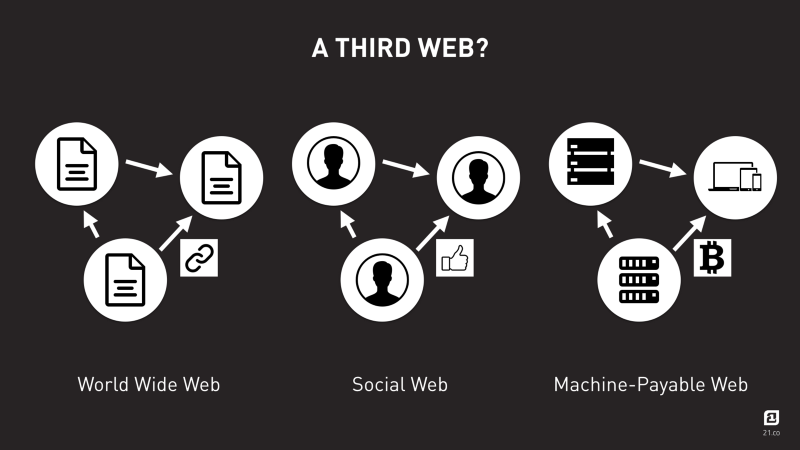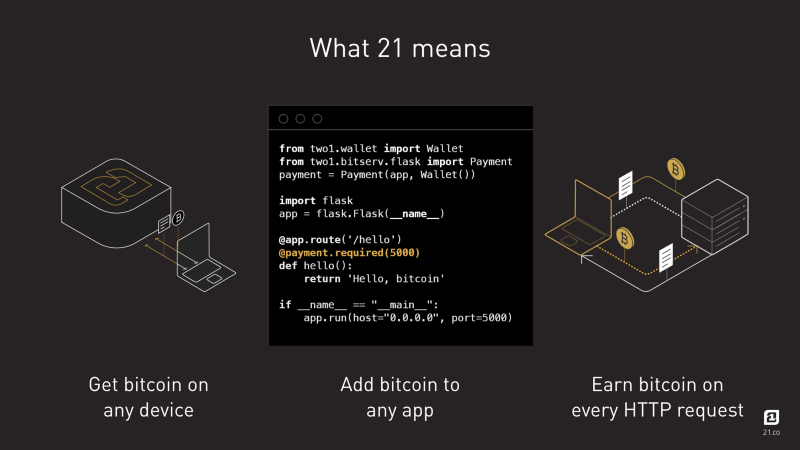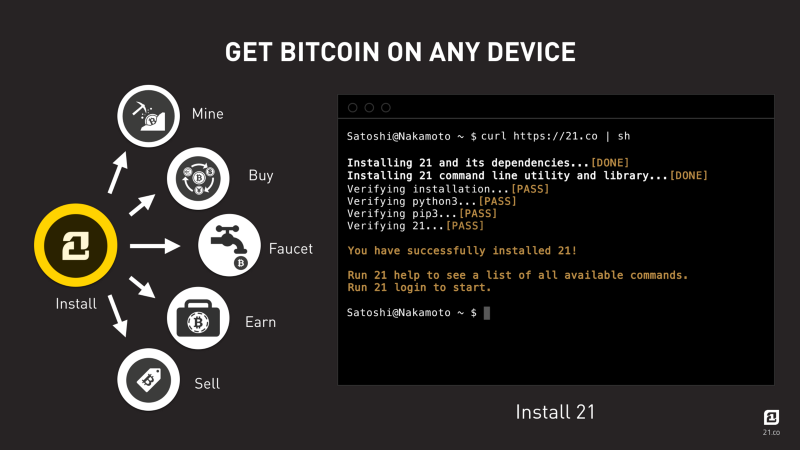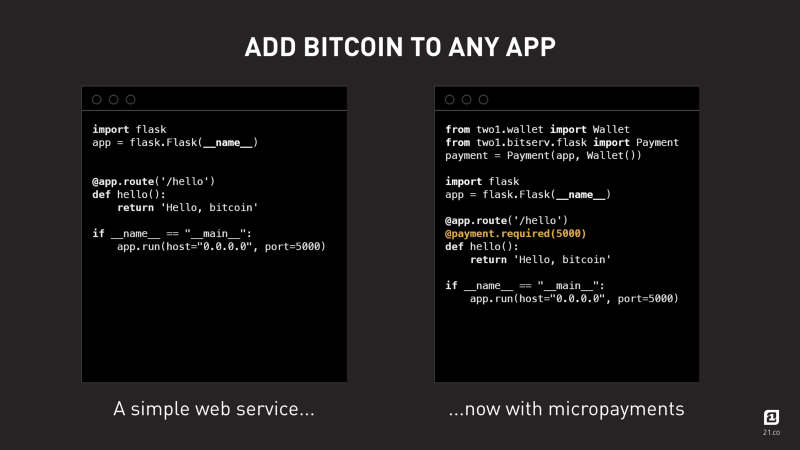21 Inc. Creates Open Source Library For Machine-Payable Web

21 Inc. has made its software free, ‘turning any computer into a bitcoin computer’, the company announced on Medium . Once a computer has installed the software, the user can get bitcoin using any device nearly anywhere without a bank account or credit cards.
The software allows users to add micropayments to any app and begin earning bitcoin on each HTTP request.
Users can also join fellow 21 developers in building a machine-payable web at slack.21.io.
To install 21, users can download the Docker image or run the command, curl https://21.co | sh.
Users can establish a profile at 21.co/signup or connect their Github and LinkedIn accounts to allow the “free faucet,” then view the introductory tutorial.
Why It’s Free
21 made the software free in the interest of building the machine-payable web, the “third web.” The first web was the World Wide Web of documents with hyperlinks among nodes. The second was the social web, linking nodes representing relationships. In the third web, links between nodes will represent payments among machines.
The reason for the machine-payable web is to allow a user to visit a new website by clicking a link versus having to go through a paywall. When trying a new paid API, the user will be able to send digital currency instead of entering a credit card number.
The machine payable web will provide a way to monetize APIs on a per-request basis rather than having to provide and accept credit cards. It will also minimize API siloization since a developer with bitcoin can contact another API as easily as importing a new library card. Thirdly, it will nullify billing and fulfillment. The HTTP request and corresponding digital currency payment will occur in the same packet series.
Bitcoin Unleashes Capabilities
Every time a program contacts a remote API and pays in digital currency, it is a machine-payable web link. Bitcoin makes this possible since it enables the machine to possess, send and receive money autonomously. Bitcoin’s private keys serve as bearer instruments.
An Internet-connected machine that has a private bitcoin wallet key has everything it needs to transact with any other machine with the same capability without human intervention. A machine with only the API keys to a PayPal account, by contrast, will not have this capability for the following reasons:
• A human must establish a bank account linked to PayPal rather than simply setting up a bitcoin address.
• The associated bank account or the PayPal account can be removed at any time without the machine’s involvement.
• It is not possible to know the machine can pay another machine on the Internet on account of the vagaries of PayPal’s global banking support.
• Any payment not regarded as typical for a human, such as small, large, frequent, global or multiplex payments, will cause closure or suspension of either the bank account or the PayPal account due to suspected fraud.
• Like the arbitrary relationship among a user’s PayPal balance and their credentials, the relationship between a bitcoin address and its private key is cryptographically irrevocable. An administrator cannot reset the password and deny a machine access to its bitcoin by having the correct private key.
Digital currency is especially suited for handling machine-to-machine payments, making it possible for developers to contact new paid web services as quickly as linking to a new website.
What 21 Bitcoin Computer Brings
The bitcoin core protocol does not solve the following issues, however: 1) securing bitcoin in the first place without mining, 2) establishing bitcoin-payable web services over HTTP, and 3) finding other developers and their bitcoin-payable web services to conduct transactions with. 21 addresses these issues.
21 makes it easy to acquire bitcoin on any device in any country other than those the U.S. sanctions. The user simply installs 21 from the source, pre-installs it on a bitcoin computer or deploys it from a Docker image. The user then acquires bitcoin in one of five ways:
• Request bitcoin from the “21 faucet.” A user who can link a social account at 21.co/signup can get free bitcoin for programming by running the “21 faucet” at the command line. This works globally and on any device. It is the fastest way to learn to program with bitcoin. A bank account or credit card is not needed; only a social networking profile.
• Purchase bitcoin. 21 provides the option of buying bitcoin through its Coinbase integration. The user links their 21.co profile to their Coinbase account and can purchase bitcoin at the command line, “21buybitcoin.”
• Mine bitcoin. A user with a 21 Bitcoin Computer (with a built-in mining chip) can mine bitcoin in the background or foreground with “21 Mine.”
• Earn bitcoin using microtasks. The “21 earn” command allows the user to perform microtasks for bitcoin. The feature is in early access release and can be tested by contacting [email protected].
• Sell machine resources in exchange for bitcoin. The “21 sell” command allows users to instruct their computer to sell spare machine resources in exchange for micropayments. The command works by turning the computer into a mini server that links to the 21 Marketplace, 21.co/mkt.
Bitcoin secured through any of the above methods can be kept in a local 21 wallet. The methods complement one another and have different prerequisites and time constraints. The company welcomes pull requests to add support for additional ways to provide digital currency or other features.
Development Capabilites Expand
The 21 command line and associated libraries make it easy to write bitcoin-payable programs once the user has bitcoin in a local wallet. The approach differs from and is complementary to projects such as Ethereum. Instead of attempting to innovate on what can be accomplished with distributed space, 21 focuses on integrating digital currency with Internet technologies such as HTTP, Python, Linux, Django and Flask.
The easiest application of distributed state is bitcoin payment. The user debits one address and credits another, which updates a database (the blockchain) distributed over thousands of nodes.
Micropayments are challenging but increasingly possible via various methods to minimize blockchain traffic. 21 provides seamless micropayment support for web applications.
It is possible for users to learn micropayments with one line of code. They can also read a 21 tutorial on using Heroku and Django. It is also possible to operate a bitcoin-payable web service on dedicated hardware such as the cloud by going to 21.co/diy to find out how to create one’s own bitcoin computer.
Once 21 has been installed, a user has their own machine-payable web service. The next step is to find buyers and sellers to do business with using bitcoin.
A Micropayments Marketplace
21 provides programmatic access to a micropayments marketplace at 21.co/mkt. Users can publish machine-payable endpoints on the marketplace, along with a profile page. Members of the 21 developer community also gather at 21’s Slack channel, slack.21.co.
21 views itself as the first capitalist network, a social network in which the main goal is not gaining favorites or likes, but trading digital goods for digital currency with like-minded peers.
Images from 21 Inc.



